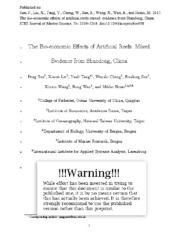| dc.contributor.author | Sun, Peng | |
| dc.contributor.author | Liu, Xiaozi | |
| dc.contributor.author | Tang, Yangli | |
| dc.contributor.author | Cheng, Wenzhi | |
| dc.contributor.author | Sun, Runlong | |
| dc.contributor.author | Wang, Xinxin | |
| dc.contributor.author | Wan, Rong | |
| dc.contributor.author | Heino, Mikko Petteri | |
| dc.date.accessioned | 2017-11-30T12:55:42Z | |
| dc.date.available | 2017-11-30T12:55:42Z | |
| dc.date.issued | 2017-10 | |
| dc.Published | Sun, Liu X, Tang, Cheng W, Sun, Wang, Wan, Heino M. The bio-economic effects of artificial reefs: mixed evidence from Shandong, China. ICES Journal of Marine Science. 2017;74(8):2239-2248 | eng |
| dc.identifier.issn | 1054-3139 | en_US |
| dc.identifier.issn | 1095-9289 | en_US |
| dc.identifier.uri | https://hdl.handle.net/1956/16963 | |
| dc.description.abstract | Artificial reefs are used to protect coastal habitats and rebuild fisheries. This engineering approach to fisheries management has gained popularity in many coastal areas, including China. In Shandong province alone, over USD 50 million were invested in artificial reefs during 2005–2013. Have artificial reefs achieved their biological and economic objectives? We compared reef and control sites in terms of catch and value per unit effort and average body length across species, based on surveys carried out during 2012–2013. We found that in aggregate, with all fish and invertebrates combined, artificial reefs did not improve the overall catches or revenues. Instead, seasonal fluctuations were prominent. However, when we allow for species-specific differences and focus on the common fish species, we find that an artificial reef can increase the catch and value per unit effort on average by approximately 40% compared to the control sites. The difference between these contrasting results occurs because some of the dominant species that comprise the bulk of the catches did not benefit from the reef, while many of the less dominant ones did so. This underlines the importance of being specific about what is meant by “benefiting fisheries” when evaluating artificial reefs, as well as when the objectives of reef projects are formulated in the first place. The positive effects of artificial reefs can be caused by the reefs themselves and by their influence on fishing patterns. Our study was not designed to separate these effects but we suggest that in Shandong, restrictions on fishing access may have been as important as the presence of the reef itself. | en_US |
| dc.language.iso | eng | eng |
| dc.publisher | Oxford University Press | en_US |
| dc.title | The bio-economic effects of artificial reefs: mixed evidence from Shandong, China | en_US |
| dc.type | Peer reviewed | |
| dc.type | Journal article | |
| dc.date.updated | 2017-09-26T11:07:42Z | |
| dc.description.version | acceptedVersion | en_US |
| dc.rights.holder | Copyright International Council for the Exploration of the Sea 2017. All rights reserved. | en_US |
| dc.identifier.doi | https://doi.org/10.1093/icesjms/fsx058 | |
| dc.identifier.cristin | 1498270 | |
| dc.source.journal | ICES Journal of Marine Science | |
| dc.relation.project | Norges forskningsråd: 255530 | |
| dc.subject.nsi | VDP::Matematikk og naturvitenskap: 400::Zoologiske og botaniske fag: 480::Marinbiologi: 497 | |
| dc.subject.nsi | VDP::Mathematics and natural scienses: 400::Zoology and botany: 480::Marine biology: 497 | |
